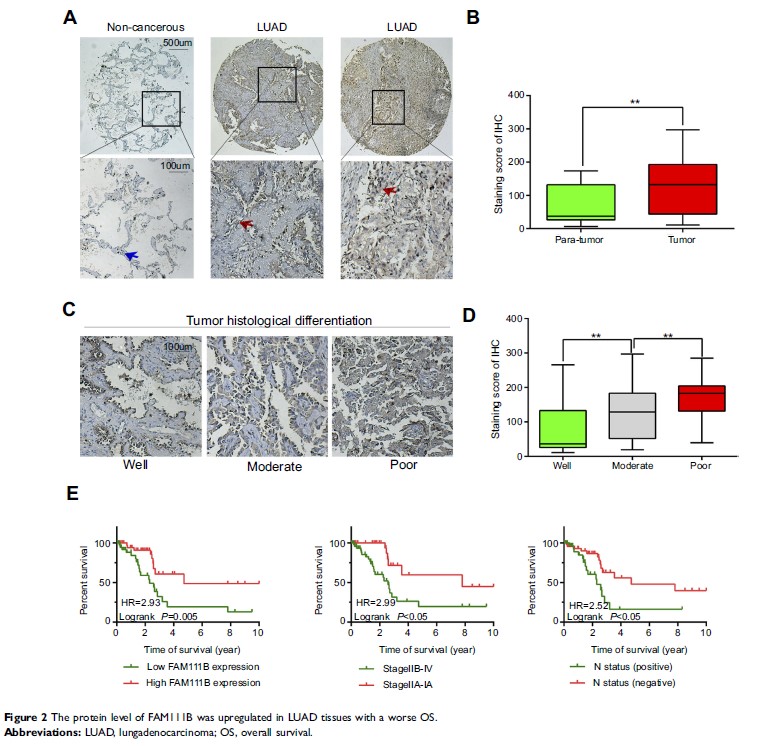9 0 5 7 8
论文已发表
注册即可获取德孚的最新动态
IF 收录期刊
- 2.6 Breast Cancer (Dove Med Press)
- 3.9 Clin Epidemiol
- 3.3 Cancer Manag Res
- 3.9 Infect Drug Resist
- 3.6 Clin Interv Aging
- 4.8 Drug Des Dev Ther
- 2.8 Int J Chronic Obstr
- 8.0 Int J Nanomed
- 2.3 Int J Women's Health
- 3.2 Neuropsych Dis Treat
- 4.0 OncoTargets Ther
- 2.2 Patient Prefer Adher
- 2.8 Ther Clin Risk Manag
- 2.7 J Pain Res
- 3.3 Diabet Metab Synd Ob
- 4.3 Psychol Res Behav Ma
- 3.4 Nat Sci Sleep
- 1.9 Pharmgenomics Pers Med
- 3.5 Risk Manag Healthc Policy
- 4.5 J Inflamm Res
- 2.3 Int J Gen Med
- 4.1 J Hepatocell Carcinoma
- 3.2 J Asthma Allergy
- 2.3 Clin Cosmet Investig Dermatol
- 3.3 J Multidiscip Healthc

FAM111B 是 p53 的直接靶标,可促进肺腺癌的恶性过程
Authors Sun H, Liu K, Huang J, Sun Q, Shao C, Luo J, Xu L, Shen Y, Ren B
Received 15 October 2018
Accepted for publication 14 March 2019
Published 17 April 2019 Volume 2019:12 Pages 2829—2842
DOI https://doi.org/10.2147/OTT.S190934
Checked for plagiarism Yes
Review by Single-blind
Peer reviewers approved by Dr Amy Norman
Peer reviewer comments 2
Editor who approved publication: Dr Federico Perche
Purpose: Lung
adenocarcinoma (LUAD) is a main subtype of lung cancer, which is the leading
cause of cancer-related deaths. The five-year survival rates of lung cancer
patients are still comparatively low. Therefore, potential therapeutic targets
are urgently needed to improve the survival of lung cancer patients. In this
study, we identified FAM111B as an oncogene and potential therapeutic target
for LUAD.
Methods: The TCGA
database and tissue microarray analysis were used to compare the expression of
FAM111B in tumor tissue and normal tissues and evaluate the relationship
between FAM111B expression and clinical survival. FAM111B was knocked down and
overexpressed to observe whether FAM111B could affect the proliferation,
migration, cell cycle, and apoptosis of LUAD cells in vivo and in vitro.
Results: FAM111B
was highly expressed in tumor tissues compared with normal tissues (P <0.01). LUAD
patients with hyper-expression of FAM111B had a lower recurrence-free survival
(P <0.01) and
shorter overall survival (P <0.01). Knocking down FAM111B inhibited cell
proliferation, migration and invasion in vitro and tumor growth in vivo.
Silencing FAM111B could arrest LUAD cells at G2/M phase and increase apoptosis.
Overexpression of FAM111B promoted the growth of lung cancer cells. FAM111B was
identified as a direct target of p53 in existing researches by chip-seq
analysis. Bioinformatics analysis predicted that FAM111B could directly bind to
BAG3 (BCL2 associated athanogene 3). When FAM111B was down-regulated, both
expression of BAG 3 and BCL2 were significantly reduced, whereas decreasing the
expression of BAG3 had no effect on FAM111B.
Conclusions: Our study
indicated that FAM111B might be an oncogene and potential therapeutic target in
LUAD which could be involved in the regulation of tumor cells by p53 signaling
pathway and play an important role in the process of cell cycle and apoptosis
by influencing the expression of BAG3 and BCL2.
Keywords: apoptosis,
p53, BAG3, FAM111B, lung adenocarcinoma, oncogene
